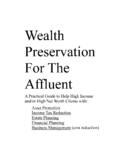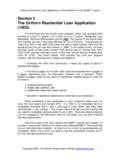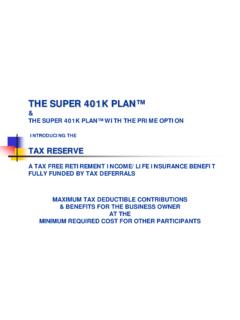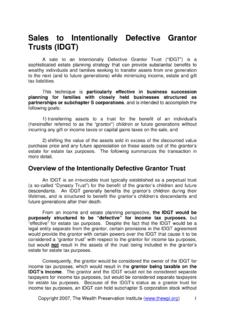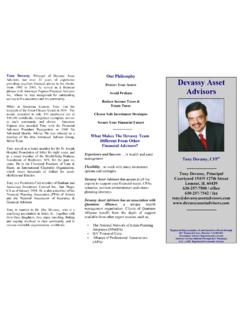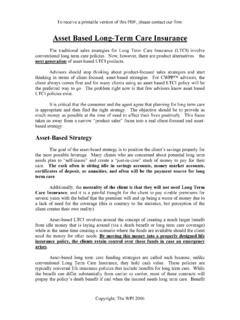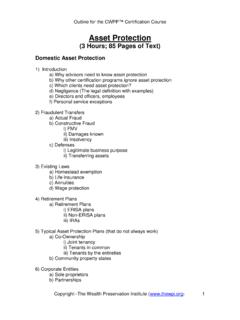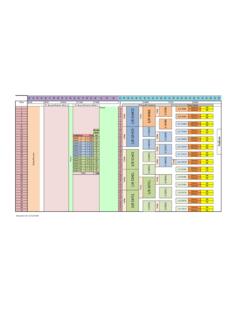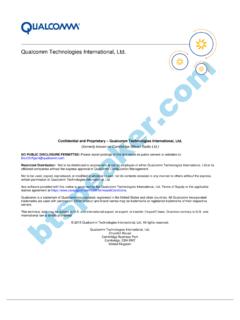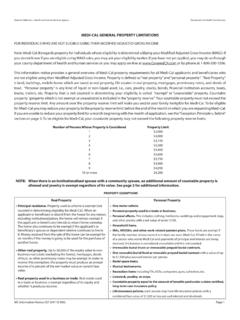Transcription of The Medicaid Planning Guidebook Table of Contents
1 Table of Contents _____. The Medicaid Planning Guidebook Table of Contents Section 1. Medicaid Planning Primer Introduction .. 1. A. Medicaid Public-Private Partnership .. 2. B. Medicaid Planner's Role .. 3. C. Medicaid Planning Objective .. 5. Section 2. Medicaid Program Overview A. The Federal-State Partnership 8. B. Governing Law .. 8. C. Scope of Coverage .. 10. D. Medicare Confusion .. 14. E. Nursing Home Medical Qualification .. 16. Section 3. Medicaid Eligibility Planning : A Systematic Approach A. Medicaid Planning Timeline .. 18. 1. Client Intake and Initial Assessment .. 18. 2. Asset Assessment .. 19. 3. Income Assessment .. 19. 4. Quick Assessment .. 19. 5. Medicaid Plan Development .. 19. 6. Medicaid Plan 20. 7. Application Filing .. 20. 8. Verification Process .. 20. 9. Eligibility Determination .. 21. 10.
2 Post-Eligibility Follow-Up .. 21. 11. Post-Death Advocacy .. 21. 1. The Medicaid Planning Guidebook _____. B. Client Intake .. 21. C. Pre- Planning vs. Crisis .23. D. Preliminary Asset and Income Assessment .. 25. Section 4. General Asset-Eligibility Rules A. Protected Assets .. 28. 1. Homestead .. 28. 2. Primary Vehicle .. 30. 3. Personal 30. 4. Cash Value Life 31. 5. Certain Business and Non-Business Property .. 31. 6. Some Qualified Retirement Accounts .. 32. 7. Single Premium Immediate Annuities (SPIA) .. 32. 8. Funeral/Burial Plans .. 33. 9. Burial Space .. 34. 10. Individual Countable Resource Allowance .. 34. B. Unprotected 35. 1. Cash and Cash Equivalents .. 36. 2. Securities and Other Investments .. 36. 3. Qualified Retirement Accounts .. 37. 4. Homestead Owned by Revocable Trust .. 37. 5. Excess Homestead Equity and Other Real Estate.
3 37. 6. Additional Vehicles .. 38. 7. Life Insurance .. 38. 8. Deferred Annuities .. 39. 9. Divestments .. 39. 10. Life Care Contracts .. 39. 11. Closely Held Business Ownership .. 40. 12. Miscellaneous Assets .. 40. C. Basic Spenddown Calculation .. 40. Section 5. Community Spouse Asset Rules A. Community Spouse Spenddown .. 42. B. CSRA Calculation .. 43. 1. Snapshot Baseline .. 43. 2. CSRA Straight Deduction .. 45. 2. Table of Contents _____. 3. One-Half Deduction .. 46. 4. Ownership Issues .. 47. C. Changing the CSRA .. 49. 1. Inflating the Countable Resources Before the Snapshot 50. a. Tap Home Equity .. 50. b. Revocable Inter Vivos Trust .. 51. 2. Fair Hearing Error Correction .. 52. 3. Fair Hearing CSRA 53. a. Conservative Method .. 53. b. Liberal Method .. 54. 4. Judicial Order .. 54. 5. Assignment of 55. D. Married with No Community Spouse.
4 56. Section 6. Asset Eligibility Strategies A. Understanding the Spenddown .. 58. 1. Countable to Non-Countable Conversion .. 58. 2. Secondary Planning 59. 3. Fair-Market Transactions .. 59. 4. Error 61. B. Basic Asset-Eligibility Strategies .. 62. Personal Property .. 63. Advantages .. 63. a. Home Renovations .. 63. b. New Home .. 64. 3. Upgrade Vehicle .. 66. 4. Pre-Pay Funeral/Burial .. 67. 5. Long-Term Care Partnership Program .. 69. C. Advanced Asset-Eligibility 71. 1. Unavailable/Non-Sellable 71. a. Unavailable Assets .. 71. 74. 2. Service Contracts .. 76. 3. Income-Producing Property .. 77. 4. Annuities and Promissory 78. 5. Strategic Divestment .. 81. 6. Caring for Disabled Family .. 82. D. Difficult Strategies .. 83. 1. Single Premium Endowment Life Insurance .. 83. 3. The Medicaid Planning Guidebook _____.
5 2. Complex Transfers and Multi-Year Strategies .. 84. 3. Family Limited Partnerships and Closely Held Businesses .. 85. 4. Balloon Annuities and Self-Cancelling Installment Notes .. 86. E. Executing Strategies .. 86. 1. Who Can Act .. 87. a. Power of Attorney .. 87. 88. 2. Documentation .. 89. a. Time Deposits .. 91. b. Securities .. 91. c. Insurance and Annuity Policies .. 92. d. Qualified Accounts .. 94. Section 7. Divestments Introduction .. 96. A. Divestment Transfers and Exceptions .. 97. 1. Transfers/Gifts .. 97. a. Direct 97. b. Overpayment .. 98. c. Underselling .. 98. d. Creating Joint 99. e. Immediate Annuities/Promissory Notes .. 100. f. Life Estate .. 101. g. Disclaimer .. 102. 2. Exceptions and Cures .. 102. a. Homestead .. 103. b. All Assets .. 104. c. Additional Exceptions .. 107. i. Intent to Dispose.
6 107. ii. Exclusively for Another Purpose .. 108. iii. Cures .. 110. iv. Hardship .. 110. 3. Lookback Period .. 111. 4. Penalty Period .. 112. a. Calculation .. 112. i. Round Down (Pre-DRA) .. 113. ii. Pro-Rata .. 113. iii. Daily Divestment Divisor .. 113. b. Start Date .. 114. 4. Table of Contents _____. B. Divestment Eligibility Strategies .. 116. 1. Historical Divestment Planning .. 116. a. Divest and Wait .. 116. b. Divest and Insure .. 119. c. Serial Divestment (Prohibited by DRA) .. 121. d. Half-a-Loaf (Prohibited by DRA) .. 122. 2. Modern Divestment 123. a. Reverse Half-a-Loaf (Partial-Cure States Only) .. 124. b. Divest and Purchase Annuity (or Make a Promissory Note) .. 126. Section 8. Trusts Introduction .. 130. A. Revocable Trusts .. 131. 1. History and Use .. 131. 2. Funding Revocable Trusts .. 132. 3. Medicaid Interplay.
7 133. 4. Strategic Uses .. 134. a. Increase CSRA .. 134. b. Revoke/Defund Trust .. 135. B. Irrevocable Trusts .. 136. 1. Non-Divestment Trusts .. 137. a. Solely-for-the-Benefit-of-Spouse Trust .. 137. b. Solely-for-the-Benefit-of a Blind or Disabled Child .. 138. c. Trust for Sole Benefit of Disabled Person under 65 .. 141. d. (d)(4)(A) Supplemental Needs Trust .. 141. e. (d)(4)(C) Pooled Trusts .. 144. f. Qualified Income Trust (QIT) (a/k/a Miller Trust) .. 146. g. Third-Party Trusts .. 147. h. Testamentary Trust .. 149. 2. Divestment 150. a. Self-Settled No-Access Trust .. 151. b. Self-Settled Limited-Access Trust .. 152. c. Third-Party Limited Access Trust .. 154. C. Practical Trust Issues .. 156. 1. Trust Creation .. 157. 2. Trust Funding .. 161. 3. Trust Management .. 163. 4. Trust 164. 5. Trust Termination .. 165.
8 A. True Revocation/Defunding .. 165. b. Trust Settlement/Fulfillment .. 167. c. Trust Busting/Reformation .. 168. 5. The Medicaid Planning Guidebook _____. Section 9. Annuities and Promissory Notes A. Annuities .. 170. 1. Medicaid Annuity 174. 2. Modern Medicaid Annuity Requirements .. 178. 3. Modern Medicaid Annuity Strategies .. 181. a. Divestment and Annuity .. 181. b. Convert Countable Assets to Annuity (Married Couple).. 184. c. Annuity as Divestment .. 186. d. Double Annuity Half-a-Loaf .. 188. e. Medicaid Annuity as Leverage .. 190. f. Qualified Medicaid SPIA .. 193. i. Qualified Account Single Patient .. 193. ii. Qualified Account Married Patient with Community Spouse . 194. iii. Qualified Account Community Spouse Owner .. 195. 4. Special Annuity 196. a. Commissions .. 197. b. Surrender Fees .. 199. c. 1035 Exchanges.
9 202. d. Qualified Rollovers/Transfers .. 205. e. Effective Date .. 208. f. Free-Look Period .. 210. g. Valuation .. 211. h. Illustrations .. 212. i. Private Annuities .. 213. B. Promissory 213. 1. Creating Promissory Notes .. 213. a. Definition .. 213. b. History of Promissory Note Uses .. 213. c. Modern Promissory 214. 2. Using Promissory Notes .. 216. a. Community Spouse Excess Asset Conversion .. 216. b. Promissory Note as Leverage .. 217. Section 10. Income Eligibility Introduction .. 220. A. Income Inventory .. 221. 1. Source Type .. 221. a. Earned Income.. 221. b. Unearned Income .. 222. c. Exclusions .. 223. 6. Table of Contents _____. 2. 223. B. Income Limits .. 225. 1. Spenddown States .. 226. 2. Income-Cap States .. 226. C. Determining the Copay .. 227. 1. Single Patient Copay .. 227. a. Determining Gross Income.
10 227. b. Determine Total Deductions .. 228. i. Personal-Needs Allowance .. 228. ii. Health Insurance Premiums .. 229. iii. Pre- Medicaid Medical Bills .. 230. iv. Guardian/Conservator Expense .. 231. v. Limited Housing Maintenance .. 231. c. Determining the Copay .. 232. 2. Married Copay .. 233. a. Determining the Spousal Allowance (MMMNA) .. 234. i. No MIA .. 236. ii. Partial MIA .. 236. iii. Full MIA .. 236. b. Calculating the Copay .. 237. D. Income Conservation Strategies .. 238. 1. Health Insurance Premiums .. 238. 2. Increase Shelter 239. 3. Fair Hearing .. 241. 4. Court 242. 5. Family Allowance .. 243. 6. Terminate Income Source .. 243. Section 11. Special Concerns for the Homestead and Family Farm Introduction .. 245. A. Valuation .. 246. 1. Scope of Property .. 246. 2. Intent to Return .. 250. 3. Establishing the Value of 251.
